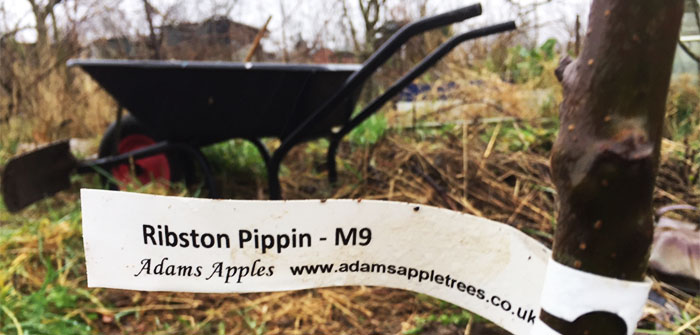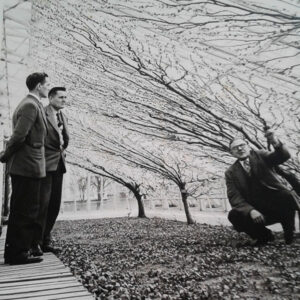
As you may have read on my social media channels, I have acquired two additional allotment ‘half’ plots for 2018. One of these is plot 44B situated immediately opposite my existing plot. Once the weeds were cleared I discovered that it has a number of small trees already growing on it including unknown plum, apple and hazelnut varieties. I have decided to expand on this tree theme and use plot 44B solely for planting dwarf fruit trees. The idea of planting trees to make a small orchard has always appealed to me and this is the ideal opportunity, perhaps I’ll even have my own Wassail in years to come! Furthermore my Great Grandad (George Cook) was something of an RHS award winning fruit grower (1920s-1950s) so I feel I owe it to him to continue the tradition. I just hope I can live up to his standards.
He who plants a tree, plants a hope.
– Lucy Larcom (American Poet 1824-1893)
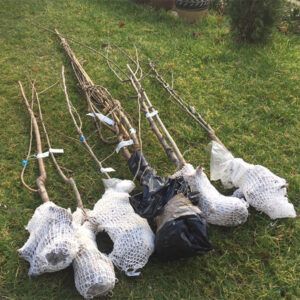
Winter is the perfect time to embark on a fruit tree planting project because the trees are in their dormancy phase. Dormant fruit trees stop growing which provides a window of a few months to re-plant them in readiness for the next growing season. Fruit trees can be purchased in pots or ordered as bare root trees. For shipping, bare root trees are typically placed inside wet shredded newspaper to keep the roots moist and then wrapped inside a plastic bag. On arrival you have a week or so to get them back in the ground, it’s a case of keeping those roots moist in the interim. Late winter is also a great time to prune any existing trees. I found the task of pruning the existing plot 44B trees (which had got quite out of hand) very therapeutic – like crafting a work of art for the future.
[hr gap=”5″]Choosing Fruit Trees: Taste and Timeliness
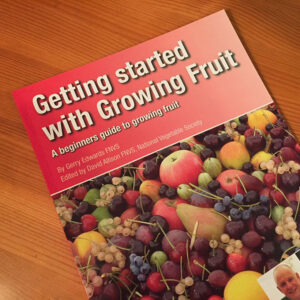
There are many factors that affect your choice of fruit tree and your selection of a specific variety. Taste and practical usefulness has to be of the utmost importance, just as with vegetables there is little point in growing something that neither you nor your family will eat. Do you want dessert apples for eating or great big cooking apples? A fruit tree is going to be around for many years and so it’s important to do some good research, read recommendations and get it right. I found the National Vegetable Society guide ‘Getting Started with Growing Fruit’ especially helpful. I think I only paid £2 for it new at one of our allotment association speaker events but it’s available for the RRP of £3.99 at www.dtbrownseeds.co.uk
I accept of course that a lot of people purchase a fruit tree based upon its price, ALDI apple trees for £5 must be very tempting as a single purchase. However, my mini orchard project has to tick my own personal OCD perfection boxes, consequently I spent a lot of time looking at recommended varieties for taste, disease resistance and ripening time. I received lots of ideas from Twitter followers and even squeezed in one of Monty Don’s recommended Ribston Pippin apple trees.
You don’t want all your fruit trees to ripen at the same time because they will spoil, instead purchase trees which ripen in different seasons to extend your harvest. It is also vital to remember that fruit trees have to cross pollinate each other (apples for apples etc.) and so in all likelihood you’ll need more than one tree. I used an online tool from www.orangepippintrees.co.uk to assist in that regard, cross checking suitability of varieties for cross-pollination.
[hr gap=”5″]Height & Dwarf Fruit Trees
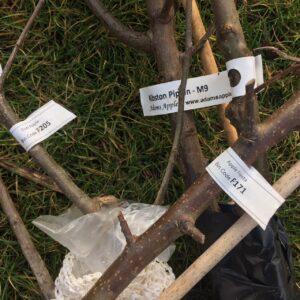
Planting fruit trees on an allotment should be done with consideration to neighbours, nobody will thank you for blocking out their much needed light, there may even be rules in your tenancy agreement (so check). Arguments and disputes come easy at allotments and so this is why I have chosen to grow trees that are unlikely to exceed 3-4 metres in height – known as dwarf fruit trees. The ultimate height of a fruit tree is dictated by its rootstock. Fruit trees are grafted onto a known rootstock base (they do not otherwise grow directly from seed into a suitable tree). In effect you choose the fruit that you want to grow and then order it on a specific rootstock to achieve your desired height and width:
I ordered the following dwarf and semi-dwarf root stocks for my trees:
- M26 Dwarfing 4-3m / 8-10ft
- M9 Dwarfing 8-2.4m / 6-8ft
- M106 Semi Dwarfing 3-4m / 10-13ft
- Julien 4.5m / 14ft
Short on Space? Try Multi-Grafted / Duo Fruit Trees
If you’re short on space you might like to consider growing multi-grafted or ‘dual’ fruit trees. These trees have more than one variety grafted on to them which means you have a tree that will provide unrelated fruit on different branches. I think this is a very exciting and somewhat magical idea and I ordered the J Parker’s Dual Fruit Trees Collection (yes they do more than bulbs).
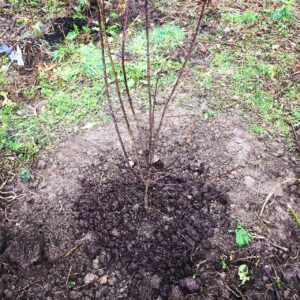
I had a busy few days last week digging holes for my trees on plot 44B, holes which must be at least 1 metre across and weed free. This width gives the new fruit trees a good chance to grow without competition for nutrients. You shouldn’t use manure within the planting hole (because it can decompose and cause the tree to sink) – just a sprinkle of lime, phosphate and root grow. Manure is fine to use as a mulch around the base of the tree after planting and ‘heeling in’, I used zoo poo! Finally new fruit trees should be staked and tied (to reduce wind rock) and protected with a plastic collar from hungry deer. I found the most cost effective solution for multiple orders of stakes and ties were available at www.green-tech.co.uk (multiple ‘staking kits’ from the likes of Suttons would cost three times more).
[hr gap=”5″]Which Fruit Trees Have I Planted?
I am growing the following varieties of fruit tree, obtained from Ashridge Trees, Adam’s Apples and J Parker’s. If I had to pick the best trees on size and quality at delivery I would pick Ashridge Trees, they took a little longer to be delivered but were worth waiting for and look like very sturdy, tall specimens. There’s absolutely nothing wrong with the trees I received from the other two companies, they’re just a little smaller and less impressive ‘out of the box’.
Fruit Tree Variety |
Fruit Season |
Fruit Tree Supplier |
| Early Apple: Beauty of Bath |
Fruit: Jul-Aug | www.ashridgetrees.co.uk |
| Mid Apple: Fiesta |
Fruit: Late Sept | www.jparkers.co.uk |
| Duo Apple: Golden Delicious and Sunset |
Fruit: Sept & Oct | www.jparkers.co.uk |
| Late Apple: Kidds Orange Red |
Fruit: Oct-Nov | www.ashridgetrees.co.uk |
| Late Apple: Ribston Pippin (Monty Don grows these) |
Fruit: Oct-Nov | www.adamsappletrees.co.uk |
| Duo Pear: Conference and Louise Bonne of Jersey |
Fruit: Sept & Nov | www.jparkers.co.uk |
| Plum: Victoria |
Fruit: Aug | www.jparkers.co.uk |
| Duo Plum: Cambridge Greengate and Marjorie’s Seedling |
Fruit: Aug & Sept | www.jparkers.co.uk |
| Plum: Mirabelle de Nancy |
Fruit: Sept | www.adamsappletrees.co.uk |
Click the image below to view my fruit tree planting plan at plot 44B:
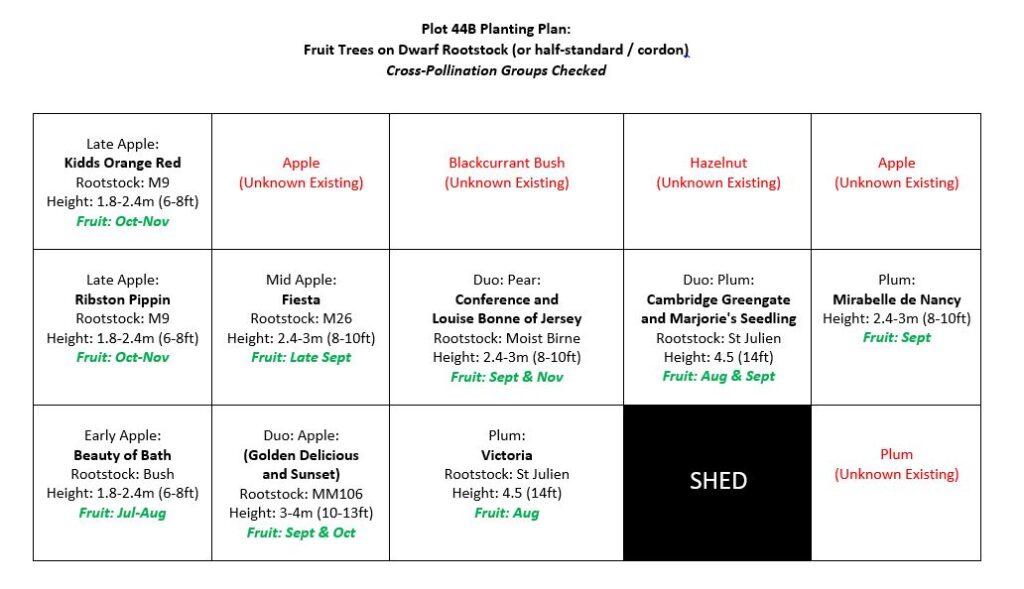
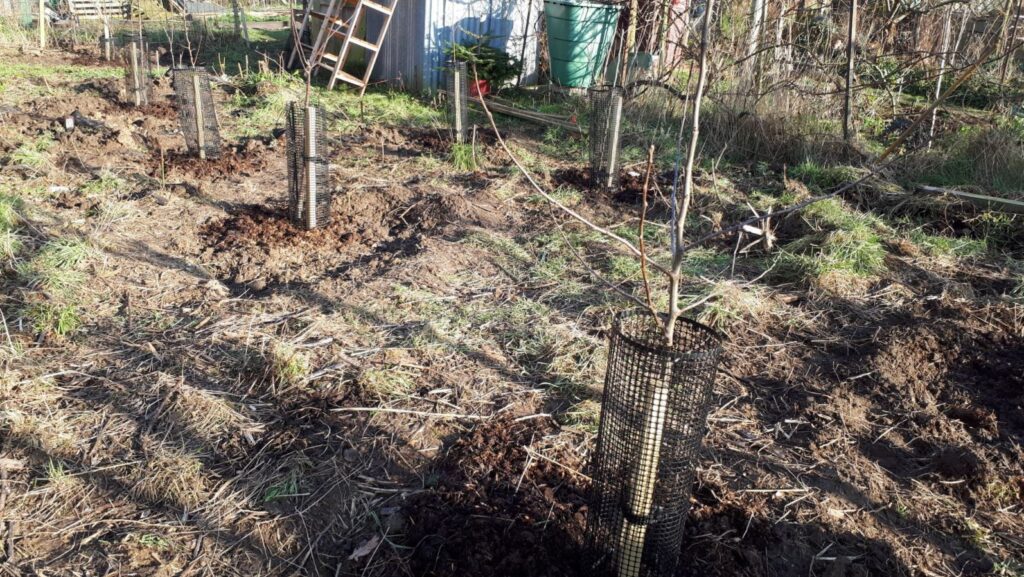
Trees are poems that the earth writes upon the sky
— Kahlil Gibran (Lebanese Poet)



